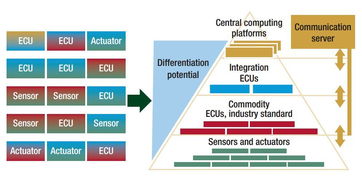Title: Understanding SOA Ecommerce Architecture
In the realm of modern ecommerce, the ServiceOriented Architecture (SOA) stands out as a robust framework for building scalable, flexible, and efficient systems. Let's delve into the intricacies of SOA in the context of ecommerce, exploring its key components, benefits, challenges, and best practices.
What is SOA?
SOA is an architectural style that advocates the creation of loosely coupled, interoperable services to support the requirements of business processes. In the ecommerce domain, SOA facilitates the development of modular applications composed of independent services that can be accessed and utilized across various channels and devices.
Key Components of SOA in Ecommerce:
1.
Services
: Services encapsulate specific business functionalities and expose them through welldefined interfaces. In ecommerce, services may include product catalog management, order processing, payment processing, user authentication, etc.
2.
Service Registry
: A service registry acts as a centralized directory where services are registered and their metadata, such as location and interface details, are stored. This allows service consumers to discover and invoke services dynamically.
3.
Service Bus
: The service bus serves as a communication backbone for integrating disparate services within the ecommerce ecosystem. It facilitates message routing, transformation, and mediation, enabling seamless interaction between services.
4.
Message Formats
: SOA promotes the use of standardized message formats such as XML or JSON for communication between services. This ensures interoperability and ease of integration across heterogeneous systems.
5.
Security Mechanisms
: Ecommerce systems handle sensitive data such as customer information and financial transactions. SOA architectures implement robust security measures, including authentication, authorization, encryption, and digital signatures, to safeguard data integrity and confidentiality.
Benefits of SOA in Ecommerce:
1.
Scalability
: SOA enables ecommerce platforms to scale horizontally by adding or removing services based on demand. This ensures optimal resource utilization and accommodates fluctuations in user traffic.
2.
Flexibility
: The modular nature of SOA allows ecommerce applications to adapt swiftly to changing business requirements. New services can be developed and integrated without disrupting existing functionalities, fostering agility and innovation.
3.
Interoperability
: SOA promotes interoperability between heterogeneous systems, enabling seamless integration with thirdparty services, legacy systems, and partner platforms. This facilitates collaboration and extends the reach of ecommerce businesses.
4.
Reusability
: Services developed within an SOA framework are designed for reusability, meaning they can be leveraged across multiple applications and business processes. This reduces development time and effort, promoting efficiency and consistency.
5.
Reliability
: By decoupling services and implementing faulttolerant mechanisms, SOA enhances the reliability and resilience of ecommerce systems. Failures in one service do not cascade to others, ensuring uninterrupted operation.
Challenges and Considerations:
1.
Complexity
: Implementing SOA in ecommerce environments introduces complexity, especially concerning service orchestration, governance, and versioning. Effective management and monitoring tools are essential to mitigate this challenge.
2.
Performance Overhead
: Service invocations across distributed environments may incur latency and overhead, impacting overall system performance. Optimization techniques such as caching, load balancing, and asynchronous communication can address these concerns.
3.
Security Risks
: The distributed nature of SOA introduces security vulnerabilities such as data exposure, injection attacks, and unauthorized access. Robust security measures must be implemented at both the service and infrastructure layers to mitigate these risks.
4.
Service Granularity
: Determining the appropriate level of service granularity is crucial in SOA design. Overly coarsegrained services may lack flexibility, while overly finegrained services can lead to increased overhead and complexity. Finding the right balance is essential.

Best Practices for SOA in Ecommerce:
1.
Design for Reusability and Modularity
: Identify cohesive business functionalities and encapsulate them into reusable services with welldefined interfaces. Strive for loose coupling to minimize dependencies and maximize flexibility.
2.
Adopt Standards and Protocols
: Embrace industry standards and protocols for message formats, service contracts, and communication mechanisms. This promotes interoperability and simplifies integration efforts.
3.
Implement Robust Governance
: Establish governance policies and frameworks to govern service lifecycle management, versioning, security, and compliance. This ensures consistency, reliability, and adherence to best practices.
4.
Focus on Performance Optimization
: Employ performance optimization techniques such as caching, compression, and asynchronous processing to enhance system responsiveness and scalability. Regular performance testing and tuning are essential.
5.
Prioritize Security
: Implement a defenseindepth approach to security, encompassing measures such as authentication, authorization, encryption, and threat monitoring. Regular security audits and updates are imperative to mitigate evolving threats.
Conclusion:
SOA offers a powerful architectural paradigm for building resilient, scalable, and interoperable ecommerce systems. By embracing the principles of modularity, loose coupling, and service reusability, businesses can unlock agility, efficiency, and innovation in their digital commerce endeavors. However, addressing challenges such as complexity, performance, and security requires careful planning, adherence to best practices, and ongoing optimization efforts. With a strategic approach and robust implementation, SOA empowers ecommerce enterprises to thrive in an everevolving digital landscape.
References:
[Oracle SOA Suite](https://www.oracle.com/middleware/technologies/soasuite.html)
[IBM SOA Solutions](https://www.ibm.com/cloud/soa)
[Microsoft Azure Integration Services](https://azure.microsoft.com/enus/services/integration/)
[Red Hat Fuse](https://www.redhat.com/en/technologies/jbossmiddleware/fuse)
文章已关闭评论!
